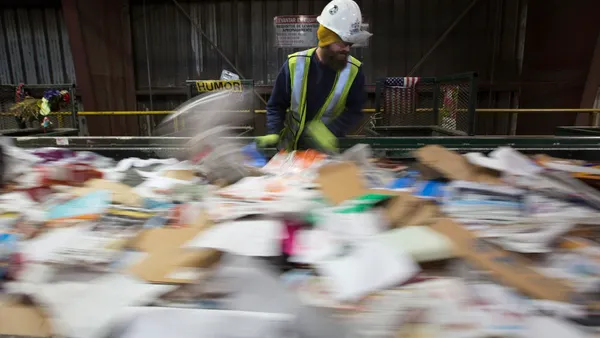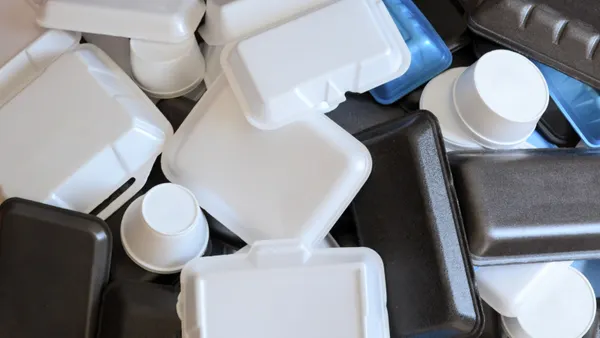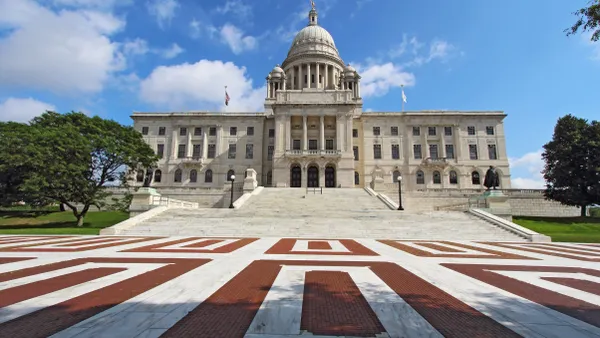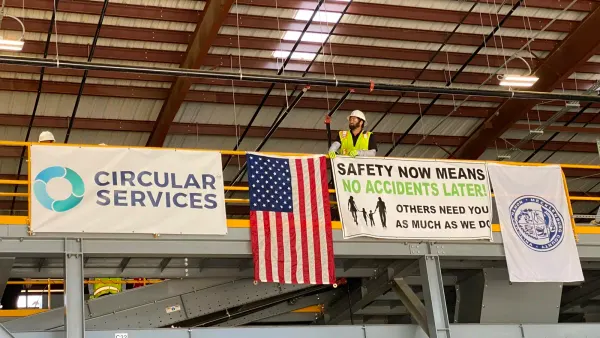As corporate sustainability commitments stack up by the week, some companies have grown quite ambitious with the recycling goals they aim to achieve over the next decade-plus. Nestlé Waters North America (NWNA) is among those taking a more recently active role in recycling advocacy to make that happen.
Last year, the company set targets to use 25% recycled content in its plastic packaging by 2021 and 50% by 2025. NWNA has invested $6 million in the Closed Loop Fund, supported The Recycling Partnership, backed Keep America Beautiful and rolled out How2Recycle labels nationwide, among various other initiatives.
Recently, the company was recognized with a Design for Recycling Award at ISRI 2019 for a version of its Pure Life water bottle made with 100% recycled content. The bottle has a pressure-sensitive label that can come off in the processing stage, rather than using adhesive which can stick to plastic flakes.
Waste Dive sat down with CEO Fernando Mercé in Los Angeles to learn more about his company's plans to boost recycled content, its current stance on extended producer responsibility policies and its perceived role in increasing consumption of a fast-growing part of the container stream.
The following interview has been edited for clarity and annotated for context.
WASTE DIVE: Why do we need bottled water in the quantity we have it in our lives today?
FERNANDO MERCÉ: There are some convenience aspects of bottled water that you can't really get in any other form. So if you're out for a jog, up in the hills around LA, you have to take your water with you. We can provide you with bottled water, we can provide you with the water which you can bottle in your own container, but there is that convenience aspect of bottled water which allows you to carry it with you all the time.
In the end it's convenience, it's consumer preferences and for us our brand line for the company is "The Healthy Hydration Company."
So aside from the discussion of whether bottled water is necessary or not, we believe that every time a person ... in our society drinks water instead of drinking something that has 30, 40, 50 grams of sugar, it's highly beneficial. We want to give you the opportunity to have access to those products.
According to the International Bottled Water Association, this product has become the most highly consumed beverage in the U.S. for two years in a row. Yet that rising prevalence has meant the advocacy around plastic bags, take-out containers and straws has begun to focus on bottled water as well. Greenpeace is in the midst of an ongoing campaign against NWNA's parent company and a small, but growing, number of local governments in Massachusetts have taken moves to restrict bottled water sales.
We often hear about plastic bag bans, but lately there has also been news on bottle bans. Is that trend considered a threat?
MERCÉ: I think the real question is: Is plastic a real issue for the environment or not? And it can come in the form of bottles or straws or bags or TV sets or whatever ... This table here has plastic in it, this chair. There's plastic everywhere. I like to take a step back and say, is plastic necessary or not? It is clearly necessary today in our society and so much of our world has been designed around using plastic. And then the other question is, can we do a better job as a society, or as a country, or even humanity in general, in reusing the plastic that we have used for primary purposes? The answer is yes.
I know this sounds contradictory, but it's a human-made natural resource. There is no good reason why this bottle, after you're done consuming it, cannot be reprocessed and made into another perfectly good food-grade plastic bottle. It should not end up in the oceans, or in a non-recycling stream, wherever it would end up.
I know that in our industry, with bottled water, a lot more can be done. [The Pure Life bottle] exemplifies what I'm just saying. And I believe that recycling rates on plastic bottles can get very close to 100%. Even if some of that plastic does not end up again in plastic bottles, it can end up in rugs, it could end up in a TV set, it could end up in many, many places. It's a natural resource and from that perspective it's not very different from aluminum or another metal which just gets reused.
Mercé breaks down how NWNA believes that will involve more education for consumers, more assistance to collection and processing service providers and then more commitment from end users to buy the material as feedstock.
We have to be out there, and that's why I was really excited to launch this bottle two years ago because I think it sends a very strong signal that if you make it, we will buy it.
Could the narrative or the threats around plastic bags and straws affect us? I think it could and I think it's really up to us to do what's right and to make sure that the whole recycling stream, the whole loop of plastic, gets solved and we end up with a 100% rate.
You've said before you want to change the narrative around what "single-use" means and ideally keep this out of that category. So this bottle can be viewed as a demonstration project essentially?
MERCÉ: It is ... I really don't want it to be confused with a marketing scheme or a PR effort. When we are successful at removing "single" out of that, and I'm talking about in action, think about the benefits for everybody. That's really powerful.
I'm not fighting the narrative of single-use, I'm actually inspiring my teams to go to the usage of plastic in a way where it doesn't end up in the environment, because that's really what the objective is for my teams and what we do in the company. That's the real power of it. This is a proof of concept that it can be done, but it's also a really good business. We're already selling it, and it's doing really well, so it's beyond just saying we've got these two bottles and we're done.
This bottle here is already not a single-use because this plastic came 100% from previously used bottles.
How should I think about the market share of that in terms of future potential? You've shown it can be done, but obviously every single bottle is not 100% yet. What would it take to get that to be the norm?
MERCÉ: What we have to do is now we have to turbo charge this. We have to take it to more of our brands. Already in California we've taken the half liter bottles that you find in most retailers in California, 50% of Arrowhead is already rPET. 50% of [Nestlé Pure Life] in the half liters is already rPET. This one is 100%. We're taking our other brands throughout the country through the same journey.
We have at least two big new product launches which are coming in using the learnings from this bottle this year and next year.
In the end, we have to do the job with everybody who is in the usage circle of plastic, we have to convince them through our brands the benefits we provide, that really this is the way you should be drinking bottled water.
Mercé also notes the company's large market share in other options, including glass bottles for brands such as Pellegrino and Perrier, as well as "ReadyRefresh" water jugs that comprise an estimated 20% of the company's business.
Those are reused up to 40 times. So before I am even talking about recycling, I'm collecting them from you, I'm washing them, and you are reusing it. That plastic goes through that cycle 35 times. At the end of the cycle we can recycle it.
Mercé mentions NWNA's recently announced goals to increase the use of recycled content as a sign of his company's broader commitment, as well as investments in rPET processing infrastructure that might not be scalable at a rapid pace otherwise.
Because most of these are small companies, they don't necessarily have the financial means to make the big investments in a $100 million rPET production facility. But big players can, and we were the first ones to do this. We can come in and say, "If you build that facility we will buy a large percentage." So you have your revenue streams more or less guaranteed, that way it frees up cash for folks to build the infrastructure they need to build. So it's really participating in the whole plastic cycle for us.
Earlier in the decade, NWNA took a very public stance to promote extended producer responsibility (EPR) policies in the U.S. over a period of multiple years and was ultimately unsuccessful. Since then, the Nestlé parent company has been involved in many voluntary initiatives to fund or boost such infrastructure.
Is that approach the new way of things? Or do you think that a broader government structure change is still needed?
MERCÉ: What I see is the places where it works best it's a private enterprise and government partnership. You need both. We are actually in touch with several state governments in the U.S. helping design legislation that actually improves ... We need legislation that allows the collection and processing industry for plastic to work really well. Today in the states we are at a recycling rate of about 30% for plastic. It needs to be higher than that.
The way we're looking at it is there are some private initiatives that we are very, very bullish about. So a Closed Loop Fund, we believe in the model and how it's working. We actually are seeing the results already of that, so we are making those investments there. Keep America Beautiful is another form.
In the end, you need private enterprise and governments to partner on some of these things, because at the local citizen level I can have an impact, but also governments can impact how collection streams are done.
The direction I don't want to see the country go to – and here is something that would be highly detrimental, and we see it in Massachusetts in some towns that have outlawed bottle water – is outlawing bottled water.
Asked whether many people would just switch to reusable containers, Mercé cited research that found this isn't always the case and sometimes younger people in particular may turn to sugary drinks out of convenience.
I have two young children and for me that's a discussion I have with them every single day. I want them to always have water accessible. Now in their case, they want to use their own containers. In my house we have the five-gallon jugs so every morning they fill up their reusable container and that's what they take to school. I think that's great. I'm supportive of that. I just want them to be drinking more water.
So to clarify, it sounds like Nestlé Waters wants to remain engaged in government policy, but EPR is not on the table at the moment? Or with the confluence of all the attention around China, recycling, plastic, could the moment be ripe again in the future?
MERCÉ: I think we want to have good policy and to the degree that we can provide guidance on what systems around the world are working and which ones are not working, we will always be involved in that.
In terms of our involvement in the design of legislation and partnerships, private and public partnerships, I think that's the way of the future, that's what we have to do. The worst thing that could happen is that legislation gets written without the input from consumers, from manufacturers. Because in the end it has to work. We have to get to 100% recycling, that's our objective as Nestlé Waters North America. It's not resisting the change, or it's not just pushing the change in our favor, it's not about that. If we go to 100% recycling we benefit, but everybody benefits.
I think we've already accepted that we have an extended responsibility and that by the investments we're making, not just in the purchase of the end product but in very upstream how recycling is done, how collection is done, how sorting is done. We're involved in all those processes already.
[This material] was not designed to be thrown away and never reused. It's a product that can be reused with no issues many, many, many times, recycled or reused, but it's a fantastic material.










